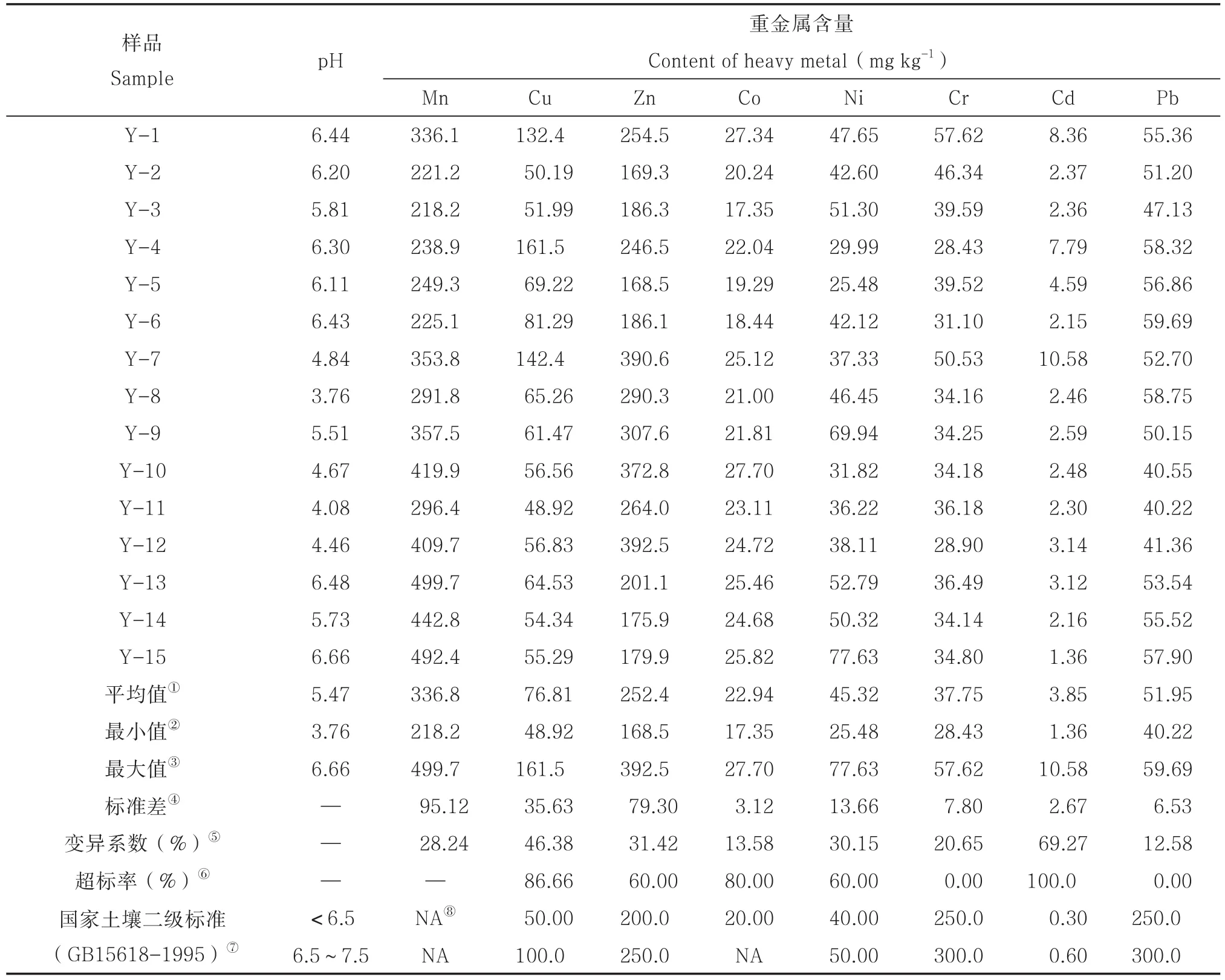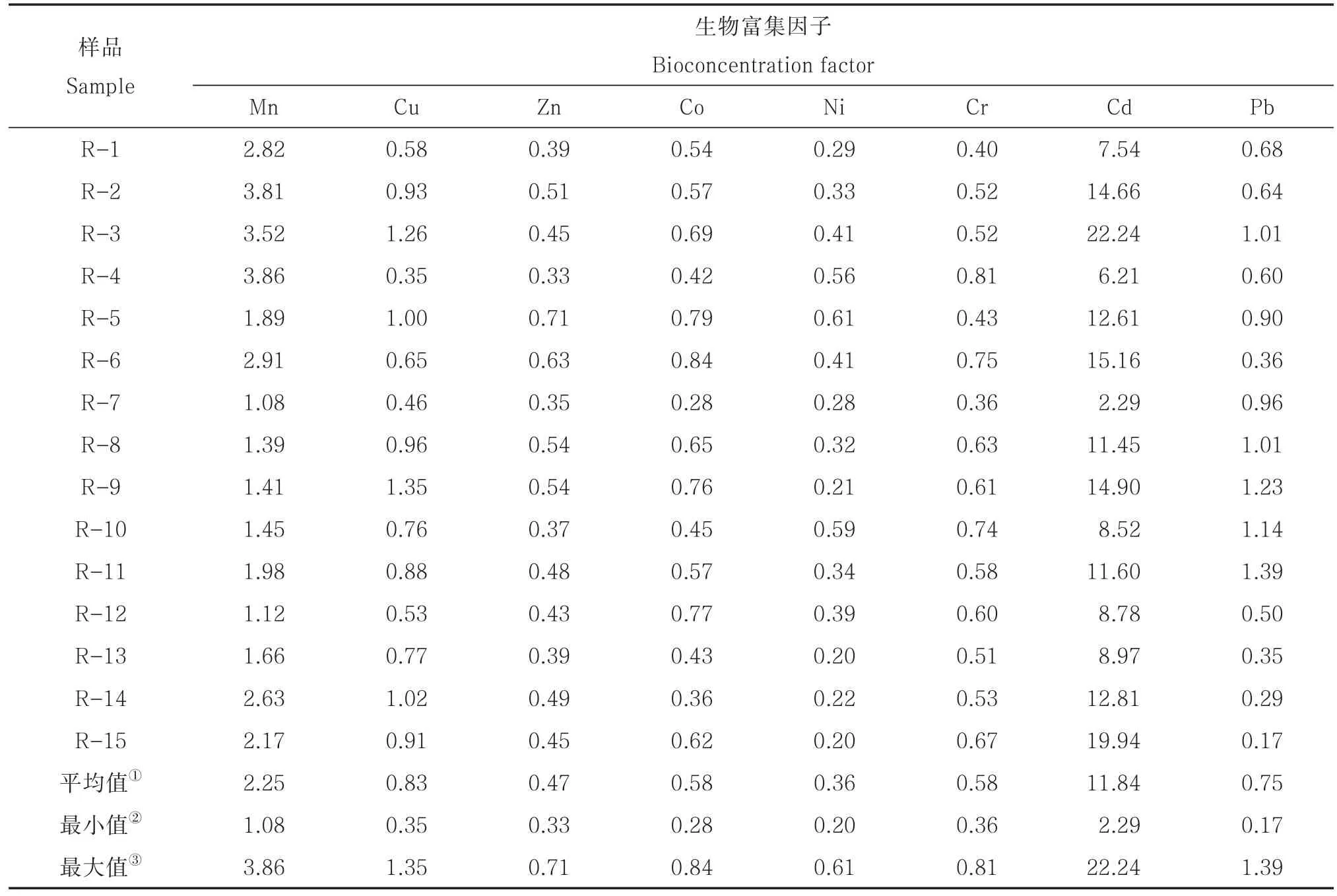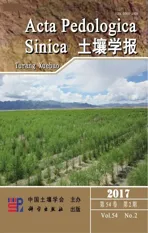湘北某镇农田土壤―水稻系统重金属累积和稻米食用安全研究*
2017-04-19蒋逸骏胡雪峰舒
蒋逸骏 胡雪峰舒 颖 蒋 颖 滕 青
(上海大学环境与化学工程学院,上海 200444)
湘北某镇农田土壤―水稻系统重金属累积和稻米食用安全研究*
蒋逸骏 胡雪峰†舒 颖 蒋 颖 滕 青
(上海大学环境与化学工程学院,上海 200444)
为研究采矿炼矿活动对农田和稻谷重金属累积的影响,评估其对人体健康的潜在风险,对湖南北部某镇一硫铁矿附近典型污染稻田土壤—水稻系统8种重金属(锰(Mn)、铜(Cu)、锌(Zn)、钴(Co)、镍(Ni)、铬(Cr)、镉(Cd)和铅(Pb))含量进行监测。结果表明:该冶炼厂附近稻田土壤Cd污染最严重,单因素污染指数达12.85,为重度污染;Cu、Zn、Co和Ni为轻度污染。土壤重金属综合污染指数达重度污染。重金属生物富集因子的研究表明:Cd和Mn极易从土壤中被水稻根系吸收,尤其Cd被水稻根系吸收的能力远超其他重金属元素;而Cu、Pb、Co、Cr、Zn和Ni相对不易被水稻根系吸收。重金属在植株组织的分配也表现出差异:Pb、Co、Cu、Cd和Cr被水稻根吸收后,主要蓄积于根部,在根部的浓度百分比分别为82.5%、70.6%、64.8%、59.4%和57.5%;Mn、Zn 和Ni被根系吸收后,会迅速向地上部组织迁移。研究区稻田出产的糙米Cd污染严重,Cd的超标率达100%,“镉米”的产出率达53.3%。糙米Cu和Ni的超标率也分别达到了40%和86.7%。若居民食用研究区稻米,每人每日摄入Cd量高于FAO/WHO推荐的标准限值5.9倍,表明研究区稻米存在很大安全风险。
采矿炼矿;稻田土壤;重金属;镉(Cd);糙米
随着工业发展,重金属对农田的污染愈发严重。据报道[1],中国有接近2.0×107hm2的农田被重金属污染,其中镉(Cd)严重污染的土壤就有2.8×105hm2。湖南是“中国有色金属之乡”,每年从湖南省输出的重金属量十分巨大[2]。据报道,2005年,湖南省生产的锌(Zn)和铅(Pb)分别占中国Zn、Pb总产量的23.7%和16.9%。在湖南全省,由于采矿和冶炼活动导致土壤污染面积约为2.8×106hm2,占全省面积的13%[3]。大规模的采矿和矿石加工,已经导致湖南稻田土壤和水稻被Cd、砷(As)和Pb等重金属严重污染[4]。
饮食是重金属进入人体的直接原因,世界上有超过半数的人口以稻米作为主食[5]。中国是世界上最大的水稻生产国和消费国。土壤重金属污染,不仅影响水稻生长发育,导致产量下降[6],还会在稻谷内大量积累,并沿食物链进入人体,危害人体健康。稻谷重金属含量的高低,直接决定是否会对人体健康产生危害。
本文以湘北某镇一硫铁矿冶炼厂附近水稻田为例,研究稻田土壤锰(Mn)、铜(Cu)、Zn、钴(Co)、镍(Ni)、铬(Cr)、Cd和Pb八种重金属元素的含量及在水稻植株的积累情况,并对研究区稻田出产稻谷的重金属累积和食用风险进行评估。本研究对揭示矿业活动重金属污染元素进入农田生态系统的途径和机理、修复污染土壤、阻止重金属进入食物链进而减少人体健康风险均有重要参考意义。
1 材料与方法
1.1 研究区概况
研究区位于湖南北部某镇,属亚热带大陆性季风湿润气候,丘陵地貌。该镇所在县矿藏资源丰富,是著名的“有色金属之乡”。全县已知的矿床、矿点有140多处,已探明的矿床、矿点40余处。全县耕地总面积达6.53×104hm2,其中稻田面积5.51×104hm2,占总耕地面积的84.5%[7]。研究土壤为水稻土(水耕人为土),成土母质为第四纪红土[8],研究区土壤为肥沃型[9]。土壤pH、有机质、全氮、全磷和盐基离子浓度如表1所示。

表1 研究区稻田土壤基本理化性状Table 1 Physico-chemical properties of the paddy soils in the studied area
1.2 样品采集和分析
该镇有一硫铁矿冶炼厂,由于冶炼废水排入邻近一灌溉溪流,使得溪流两岸近千亩稻田均不同程度地受污染。野外调查表明,稻田的影响程度,与溪流污染状况和距离有密切关系。
距冶炼厂约5 km,受污溪流刚入地势平缓的稻区,两岸稻田污染最重,有的稻田表土呈褐红色。本文以此处20 hm2典型污染稻田为研究对象,对土壤—水稻植株系统重金属含量作监测。于2012年9月下旬湖南中季稻成熟季,采用GPS定位,对研究稻田进行网格化采样。每个网格单元均用十字交叉法采集耕作层(0 ~ 20 cm)的混合土样约1 kg,装入聚乙烯塑料袋中,送回实验室。土壤样品共计15个(编号:Y-1~Y-15)。同时,在每个网格单元,用蛇形法采集对应水稻成熟植株样,共计15个(编号:R-1~R-15)。
土样于实验室中自然风干、磨碎,分别过2 mm 和0.149 mm筛,备用。
水稻植株样品带回实验室后,去除杂物,用蒸馏水洗净。每样分为根、茎、叶、稻壳和稻米样,烘干至恒重,用粉碎机粉碎后,密封备用。
土壤和水稻样品消解方法:称取0.2000 g 左右过0.149 mm筛的风干土样于聚四氟乙烯坩埚中,加入混合酸(HF-HClO4-HNO3)进行消解。称取水稻各组织烘干粉末2.0000 g(稻根样1.0000 g)置于三角烧瓶中,加HNO330 ml浸泡过夜后,低热消解,随后加入2 ml HClO4继续消解至终点。
土壤和水稻样品重金属测定:消解液重金属(Cu、Zn、Cr、Ni、Co、Mn)含量用电感耦合等离子体发射光谱仪(ICP-AES:Prodigy型,利曼仪器有限公司,美国)测定,仪器误差为1.52%~3.43%,相对标准偏差1.34%~2.18%;Cd、Pb含量用石墨炉原子吸收法(GF-AAS:Z E E n i t 6 0 0/6 5 0,耶拿公司,德国)测定,仪器误差为2.3 1%~4.1 3%,相对标准偏差1.85%~2.89%。土壤重金属分析过程用国家标准土壤样品(GSS-6)进行分析质量控制;水稻样品重金属元素分析过程用湖南大米标准样品(GBW10045)进行分析质量控制。每测试10个样品,插入一个居中浓度的标准液校正测定值。
1.3 重金属污染指标计算
内梅罗指数:表示重金属污染物对土壤环境和生态环境的危害程度,分为单因素污染指数和综合污染指数。单因素污染指数[10]:

式中,Pi为土壤中某重金属 i 的单因素污染指数;Ci为土壤中某重金属 i 实测平均含量;Si为i的标准参考值(取GB15618-1995的二级含量限值);本研究i包括Mn、Cu、Zn、Co、Ni、Cr、Cd和Pb八种重金属。

式中,Pimax为样区某重金属i单因素污染指数的最大值;P—为单污染指数的加权平均值;wi为重金属的权重,Hg、Pb、Cd和As为3,Zn、Cu、Cr和Ni 为2[12]。依据上述单因素污染指数和综合污染指数的大小,将土壤重金属污染现状分为如下4个等级:(1)P<1. 0,清洁;(2)P = 1. 0 ~ 2.0,轻度污染;(3)P = 2.0~3.0,中度污染;(4)P >3. 0,重度污染。
生物富集因子(Bioconcentration factor,BCF):表示植物从土壤中吸收某种特定重金属并积累在植物体内的能力。计算公式[13]:

式中,Cplant和Csoil分别代表了植物某部位的重金属浓度和对应的土壤重金属浓度,以烘干重为基准。
迁移因子(Translocation factor,TF):表示植物体内重金属从根部迁移到地上部位的能力。计算公式[14]

式中,Cshoot和Croot分别表示植物地上部位和植物根部重金属浓度。
重金属每人每日摄入量(Per capita daily ingestion of heavy metals,DI):研究区内居民经稻米途径摄入重金属量,采用每人每日摄入量来计算。公式表达如下[15]

式中,FIR为食物的摄入率,g person-1d-1。根据我国平均食物消费结构,人均每年消费稻麦等谷类粮食作物206 kg,假设谷类全部为大米,则成人每天消费稻米0.339 kg[16];C为食物中重金属含量,mgkg-1;1 000为单位转换系数,使mg d-1person-1转换成μg d-1person-1。
2 结果与讨论
2.1 稻田土壤重金属含量
研究区域水稻土发育于第四纪红土,质地黏重,多呈酸性或强酸性;但由于受淹水作用影响,个别样点已趋中性(表2)。15个水稻土监测样点,位于炼矿废水排放导致的污染溪流两岸。以国家土壤环境质量二级标准(GB15618-1995)为基准,对稻田土壤重金属含量(表2)进行评价。结果表明:土壤Cd含量,超标率达到了100%,污染十分普遍;Cu、Zn、Co、Ni的超标率也分别达到了86.7%、60%、80%和60%。土壤Cd的单因素污染指数为12.85,达到重度污染;Cu、Zn、Co 和Ni的单因素污染指数依次为1.54、1.26、1.15和1.13,均为轻度污染(图1),依然不可忽视。研究区稻田综合污染指数达到9.39,已达到重度污染程度,表明该区域土壤已遭受严重污染。
2.2 水稻重金属生物富集因子
根据研究区域水稻根部重金属生物富集因子(表3),所研究重金属可以分为两大类:一类为Cd、Mn,极易从土壤中被水稻根系吸收;另一类为Cu、Pb、Co、Cr、Zn和Ni,相对不易被水稻根系吸收。可以看出,Mn、Cu、Zn、Co、Ni、Cr、Cd和Pb八种重金属中,Cd从土壤迁移至水稻根系的能力远超其他重金属,生物富集因子平均值为11.84,最高值达到了22.24。Cd更易从土壤被水稻根系吸收[17]。Cu、Pb和Zn等重金属在水稻生长中后期基本不会再被水稻根系吸收进入体内,但对Cd的吸收却依然十分旺盛[18]。Mn也很容易被水稻根系吸收,生物富集因子平均为2.25。Cu、Pb、Co、Cr、Zn和Ni的生物富集因子多数小于1.00,说明均不易从土壤迁移至水稻根部;但也有个别样点超过1.00(表3),可能与不同样点重金属共存情况、土壤理化性质和肥料施用不同等因素有关[19]。
2.3 水稻植株重金属积累和分布
依据重金属元素在水稻植株各部位(根、茎、叶、糙米和稻壳)的浓度百分比(图2),也可以将所研究重金属分为两大类:一类为Pb、Co、Cu、Cd和Cr,主要累积于植株根部,在根部的浓度百分比依次为82.5%、70.6%、64.8%、59.4%和57.5%;另一类为Mn、Zn和Ni,根部的浓度百分比只为16.3%、29.9%、49.9%,而在地上部茎、叶和稻谷各部位浓度显著增加。

表2 研究区稻田土壤重金属含量Table 2 Contents of heavy metals in the studied paddy soils

图1 研究区稻田土壤重金属单因素污染指数Fig. 1 Singe-factor pollution indices of heavy metals in the studied paddy fields

表3 研究区稻田水稻根部重金属生物富集因子Table 3 Heavy metals bioconcentration factors in rice roots in the studied paddy fields
植物地上部重金属过量会毒害和抑制植物生长。对于非必需重金属元素,植物自身会通过减少吸收或截留在根部细胞等调节方式,使体内重金属含量维持在一定水平[20-21]。Pb主要富集在水稻根部,少量分布于茎、叶和稻壳中,而在糙米中的浓度非常低。前人[22]的研究也表明,水稻根部Pb浓度在抽穗期达到峰值,在茎和叶中的含量也会持续增大,但在糙米中的含量很低。Pb在水稻体内含量分配的差异与Pb在植株各组织及细胞中的存在形式和移动性有关[23]。Cu主要截留在水稻根部,会使根病变成棕色,作物发芽减少,从而降低产量[24]。本研究也表明,根部Cu浓度百分比达60%以上,茎、叶和壳的浓度较低,但稻米中的浓度接近叶部浓度。说明Cu主要被拦截于水稻的根部,只有少部分转移至水稻的其他部位,包括稻米中。Cr和Co也大部分在根部截留,较地上部富集量大很多。Cd对水稻有很大的毒害作用,水稻根部吸收Cd后主要富集在根部,根部Cd浓度百分比达59.4%,但有近40%的浓度比集中在水稻地上部。研究表明,木质部的传输决定Cd从水稻根部迁移至地上部,迁移至糙米中则主要由韧皮部的传输决定[25]。
Mn、Zn和Ni对水稻的毒害较小,且作为水稻的营养元素大量迁移至水稻地上部。Mn主要蓄积在水稻叶部,叶部Mn浓度百分比达50%以上(图2),当叶部浓度达到0.5 ~ 2 mg kg-1时,会降低水稻的光合作用[26]。植物叶中Mn含量的高低往往受体内磷含量影响,当体内磷含量较低时会释放较多羧化物,从而使植物叶中Mn含量维持在较高的水平[27]。Zn作为动植物的营养元素被吸收后,并不会被根部截留,而是主动由木质部传输至地上部,为植物提供营养[28]。Zn主要蓄积在水稻茎部,茎部Zn浓度百分比达51.2%(图2)。Zn在植物体内含量还受磷含量影响,体内磷含量较高时,Zn含量较低,但在不同生长期会有不同的影响[29]。Ni在水稻根部和地上部的浓度百分比基本相同,均为50%左右(图2)。Ni在水稻地上部主要蓄积在茎和叶部,且浓度百分比也十分接近。这说明水稻各组织对Ni的吸收和富集具有相似性[30]。虽然Ni是植物必需的微量元素,但过量的Ni会降低水稻呼吸作用[31],削弱水稻的氮同化作用,毒害水稻幼苗[32]。

图2 水稻植株各组织重金属浓度百分比Fig. 2 Distribution of heavy metals(in percentage)in different tissues of a rice plant
2.4 水稻糙米重金属含量
本研究对水稻地上部各组织的重金属迁移因子进行计算,结果见表4。总体看,水稻茎、叶的重金属迁移因子显著高于糙米。因为重金属对水稻的毒害作用,使水稻产生一系列耐性机理阻碍其迁移,防止进一步转移至籽实[33]。
稻米是主粮,稻米重金属含量会深刻影响人体健康。Mn在糙米中的含量远低于茎和叶,Cr和Pb迁移至糙米的能力几乎为零。Zn不易向糙米富集,但相对于其他非必需元素,Zn迁移至糙米的能力最强(表4)。Cu迁移至糙米的能力仅次于Zn(表3)。水稻能通过暂存在叶中的Cu直接从根部迁移至糙米中[34]。微量的Ni有助于植物的氮代谢,但过量的Ni则会毒害水稻分蘖,使穗重量降低[35]。研究表明[36],水稻籽实能选择性地“优先”吸收Cd。糙米对Cd的吸收有显著的基因型差异,此外,Cd在土壤中的有效性以及土壤种类、酸碱度、肥料使用和气候条件等也会影响糙米Cd含量[37]。
水稻糙米中,Mn、Cu和Zn含量显著高于Cd(表5)。但前者生理毒性低,且又是水稻的营养元素。Cd对水稻无任何营养意义,且有很强的生理毒性。糙米Cd含量是评估稻米安全和质量的一个重要指标。在食品安全国家标准(GB2762-2012)中,糙米Cd 含量0.2 mg kg-1为限制值。糙米Cd含量超过1 mg kg-1时,称为“镉米”[38],食用后会对人体健康产生严重危害,因而又称“毒大米”。对研究区稻田产出糙米的Cd含量进行评价,糙米Cd超标率达100%,与农田土壤Cd污染程度一致;“镉米”的产出率达53.3%。充分说明由于受炼矿废水排放的影响,研究区域已受到Cd的严重污染,尤其毒大米产出比例很高,应引起高度重视。糙米Cu和Ni的超标率也分别达到了40%、 86.7%,同样不容忽视。

表4 研究区稻田水稻植株地上部重金属迁移因子Table 4 Heavy metals translocation factors in rice shoots in the studied paddy fields

表5 研究区稻田糙米重金属含量Table 5 Contents of heavy metals in the brown rice produced in the studied paddy fields
2.5 稻米食用风险评价

图3 研究区居民食用研究稻田产出稻米每人每日重金属摄入量Fig. 3 Per capita daily ingestion of heavy metals of the local residents through consumption of the rice produced in the studied paddy fields
假定研究区域周边居民以当地出产的稻米为主食,估算出居民因食用稻米摄入的Cu、Zn、Ni、 Cr、Cd和Pb量分别为2 732、7 085、464、85、410和37 μg d-1person-1(图3)。其中,Cu、Zn、Ni、Cr和Pb的摄入量低于FAO/WHO推荐限量标准[39],但Cd摄入量为FAO/WHO推荐允许限量标准的5.9倍(图3)。重金属在稻米中主要与蛋白质结合[40];进入人体后,可溶性蛋白质能络合Cd等重金属,可一定程度缓和重金属对人体的毒性[41]。另一方面,还应考虑多种重金属被人体吸收后的复合效应,不能只考虑单一暴露源进行评价[42]。因此,这一评价方式也有局限。研究区域稻米Cd的累积,对当地居民身体健康构成潜在威胁。
3 结 论
湘北某镇一硫铁矿冶炼厂废水排放,污染灌溉溪流,使得溪流两岸约20 hm2稻田土壤重金属污染严重:土壤Cd的超标率达100%,Cd单因素污染指数达重度污染,Cu、Zn、Co和Ni也达到轻度污染,重金属综合污染指数达重度污染。Cd和Mn极易从土壤被水稻根部吸收,其他重金属元素相对不易被水稻根吸收。重金属元素Pb、Co、Cu、Cd 和Cr被水稻根部吸收后,主要累积于根部;Mn、Zn和Ni被根部吸收后,会迅速迁移至地上部。研究区稻田出产的糙米Cd污染严重,Cd的超标率达100%,“镉米”的产出率达53.3%。糙米Cu、Ni的超标率也分别达40%和86.7%。若居民食用研究区出产稻米,每人每日摄入Cd量高于FAO/WHO推荐的标准限值5.9倍。表明该典型污染区稻米已存在很大食用风险。
[1]Li P,Wang X,Zhang T,et al. Effects of several amendments on rice growth and uptake of copper and cadmium from a contaminated soil. Journal of Environmental Sciences,2008,20(4):449—455
[2]Liao B,Guo Z,Probst A,et al. Soil heavy metal contamination and acid deposition:Experimental approach on two forest soils in Hunan,southern China. Geoderma,2005,127(1/2):91—103
[3]Li Z,Feng X,Li G,et al. Mercury and other metal and metalloid soil contamination near a Pb/Zn smelter in east Hunan Province,China. Applied Geochemistry,2011,26(2):160—166
[4]Wang M,Chen W,Peng C. Risk assessment of Cd polluted paddy soils in the industrial and township areas in Hunan,southern China. Chemosphere,2016,144:346—351
[5]Wu W,Cheng S. Root genetic research,an opportunity and challenge to rice improvement. Field CropsResearch,2014,165:111—124
[6]Nayak A K,Raja R,Rao K S,et al. Effect of fly ash application on soil microbial response and heavy metal accumulation in soil and rice plant. Ecotoxicology and Environmental Safety,2015,114:257—262
[7]Du Y,Hu X F,Wu X H,et al. Affects of mining activities on cd pollution to the paddy soils and rice grain in Hunan province,central south China. Environmental Monitoring and Assessment,2013,185 (12):9843—9856
[8]张甘霖,王秋兵,张凤荣,等. 中国土壤系统分类土族和土系划分标准. 土壤学报,2013,50(4):826—834
Zhang G L,Wang Q B,Zhang F R,et al. Criteria for establishment of soil family and soil series in Chinese Soil Taxonomy(In Chinese). Acta Pedologica Sinica,2013,50(4):826—834
[9]孙波,张桃林,赵其国. 南方红壤丘陵区土壤养分贫瘠化的综合评价. 土壤,1995,27(3):119—128
Sun B,Zhang T L,Zhao Q G. Evalution of soil nutrient depletion in hilly red soil region of southern China(In Chinese). Soils,1995,27(3):119—128
[10]杜艳,常江,徐笠. 土壤环境质量评价方法研究进展.土壤通报,2010,41(3):749—756
Du Y,Chang J,Xu L. Progress on assessing methods of soil environmental quality(In Chinese). Chinese Journal of Soil Science,2010,41(3):749—756
[11]胡淼,吴家强,彭佩钦,等. 矿区耕地土壤重金属污染评价模型与实例研究. 环境科学学报,2014,34 (2):423—430
Hu M,Wu J Q,Peng P Q,et al. Assessment model of heavy metal pollution for arable soils and a case study in a mining area(In Chinese). Acta Scientiae Circumstantiae,2014,34(2):423—430
[12]崔立强,严金龙,丁成,等. 盐城市不同功能区地表灰尘重金属污染特征及评价. 环境污染与防治,2014,36(9):712,17
Cui L Q,Yan J L,Ding C,et al. Characteristic and assessment of heavy metals pollution in urban surface dust of different functional areas of Yancheng(In Chinese). Environmental Pollution and Control,2014,36(9):7—12,17
[13]Galal T M,Shehata H S. Bioaccumulation and translocation of heavy metals by plantago major l. Grown in contaminated soils under the effect of traffic pollution. Ecological Indicators,2015,48:244—251 [14]Zhang Y,Luo XJ,Mo L,et al. Bioaccumulation and translocation of polyhalogenated compounds in rice (Oryza sativa L)planted in paddy soil collected from an electronic waste recycling site,south China. Chemosphere,2015,137:25—32
[15]Fang Y,Sun X,Yang W,et al. Concentrations and health risks of lead,cadmium,arsenic,and mercury in rice and edible mushrooms in China. Food Chemistry,2014,147:147—151
[16]雷鸣,曾敏,王利红,等. 湖南市场和污染区稻米中As、Pb、Cd污染及其健康风险评价. 环境科学学报,2010,30(11):2314—2320
Lei M,Zeng M,Wang L H,et al. Arsenic,lead,and cadmium pollution in rice from Hunan markets and contaminated areas and their health risk assessment(In Chinese).Acta Scientiae Circumstantiae,2010,30 (11):2314—2320
[17]Z h a o K,L i u X,X u J,e t a l. H e a v y m e t a l contaminations in a soil-rice system:Identification of spatial dependence in relation to soil properties of paddy fields. Journal of Hazardous Materials,2010,181 (1/3):778—787
[18]朱姗姗,张雪霞,王平,等. 多金属硫化物矿区水稻根际土壤中重金属形态的迁移转化. 农业环境科学学报,2013,32(5):944—952
Zhu S S,Zhang X X,Wang P,et al. Effect of rhizospheric environment of rice on bioavailability and mobility of Cd,Cu,Pb and Zn in AMD polluted paddy soil(In Chinese). Journal of Agro-Environment Science,2013,32(5):944—952
[19]乔振芳,彭世彰,徐俊增,等. 稻田土壤重金属赋存形态·运移规律及灌溉的影响. 安徽农业科学,2011,39(16):9698—9700,9702
Qiao Z F,Peng S Z,Xu J Z,et al. Chemical forms and migration of soil heavy metals in paddy and effects of irrigation(In Chinese). Journal of Anhui Agricultural Sciences,2011,39(16):9698—9700,9702
[20]Hameed A,Rasool S,Azooz M M,et al. Chapter 24 - heavy metal stress:Plant responses and signaling// Ahmad P. Plant metal interaction. India:Elsevier,2016:557—583
[21]Kumar R,Mishra R K,Mishra V,et al. Chapter 13 -detoxification and tolerance of heavy metals in plants// Ahmad P. Plant metal interaction. India:Elsevier,2016:335—359
[22]杨玉峰,黄标,齐雁冰,等. 长江三角洲典型地区水稻籽粒中重金属含量及空间分布特征. 土壤,2009,41 (1):42—48
Yang Y F,Huang B,Qi Y B,et al. Spatial variation of heavy metals in rice grains in a typical area of Yangtze River Delta Region(In Chinese). Soils,2009,41 (1):42—48
[23]杨祥田,周翠,何贤彪,等. 田间试验条件下不同基因型水稻对Cd和Pb的吸收分配特征. 农业环境科学学报,2013,32(3):438—444
Yang X T,Zhou C,He X B,et al. Uptake and partition of Cd and Pb among rice genotypes in contaminated paddy soil(In Chinese). Journal of Agro-Environment Science,2013,32(3):438—444
[24]Huang Y,Hu Y,Liu Y. Heavy metal accumulation in iron plaque and growth of rice plants upon exposure to single and combined contamination by copper,cadmium and lead. Acta Ecologica Sinica,2009,29(6):320—326
[25]Uraguchi S,Fujiwara T. Cadmium transport and tolerance in rice:Perspectives for reducing grain cadmium accumulation. Rice,2012,5(1):1—8
[26]Lidon F C,Barreiro M G,Ramalho J C. Manganese accumulation in rice:Implications for photosynthetic functioning. Journal of Plant Physiology,2004,161 (11):1235—1244
[27]Lambers H,Hayes P E,Laliberte E,et al. Leaf manganese accumulation and phosphorus-acquisition efficiency. Trends in Plant Science,2015,20(2):83—90
[28]虞银江,廖海兵,陈文荣,等. 水稻吸收、运输锌及其籽粒富集锌的机制. 中国水稻科学,2012,26(3):365—372
Yu Y J,Liao H B,Chen W R,et al. Mechanism of Zn uptake,translocation in rice plant and Zn-enrichment in rice grain(In Chinese). Chinese Journal of Rice Science,2012,26(3):365—372
[29]Zhang W,Liu D,Li C,et al. Zinc accumulation and remobilization in winter wheat as affected by phosphorus application. Field Crops Research,2015,184:155—161
[30]K a m r a n M A,E q a n i S A,B i b i S,e t a l. Bioaccumulation of nickel by E. sativa and role of plant growth promoting rhizobacteria PGPRs)under nickel stress. Ecotoxicology and Environmental Safety,2016,126:256—263
[31]Llamas A,Sanz A. Organ-distinctive changes in respiration rates of rice plants under nickel stress. Plant Growth Regulation,2007,54(1):63—69
[32]Mishra P,Dubey R S. Nickel and Al-excess inhibit nitrate reductase but upregulate activities of aminating glutamate dehydrogenase and aminotransferases in growing rice seedlings. Plant Growth Regulation,2011,64(3):251—261
[33]仲晓春,陈京都,郝心宁. 水稻作物对重金属镉的积累、耐性机理以及栽培调控措施进展. 中国农学通报,2015,31(36):1—5
Zhong X C,Chen J D,Hao X N. Research process of accumulation,tolerance mechanism and cultivation control measures of heavy metal cadmium in rice crops (In Chinese). Chinese Agricultural Science Bulletin,2015,31(36):1—5
[34]Yan Y P,He J Y,Zhu C,et al. Accumulation of copper in brown rice and effect of copper on rice growth and grain yield in different rice cultivars. Chemosphere,2006,65(10):1690—1696
[35]康立娟,谢忠雷. 镍对玉米和水稻污染效应及累积规律的研究. 农业环境科学学报,2008,27(6):2315—2318
Kang L J,Xie Z L. Pollution effects and accumulation rules of nickel in corn and rice(In Chinese). Journal of Agro-Environment Science,2008,27(6):2315—2318
[36]魏建宏,范美蓉,廖育林,等. 赤泥施用量在铅锌矿区土壤-水稻系统中的改良效应. 土壤通报,2013,44 (3):723—729
Wei J H,Fan M R,Liao Y L,et al. Effects of red mud on the remediation in soil-rice system on lead and zinc mining area soil(In Chinese). Chinese Journal of Soil Science,2013,44(3):723—729
[37]李先喆,徐庆国,刘红梅. 栽培条件对水稻镉积累的影响研究进展. 湖南农业科学,2015(3):144—147
Li X Z,Xu Q G,Liu H M. Research advance in effects of cultivation conditions on cadmium absorption and accumulation in rice(In Chinese).Hunan Agricultural Sciences,2015(3):144—147
[38]孙聪,陈世宝,宋文恩,等. 不同品种水稻对土壤中镉的富集特征及敏感性分布(SSD). 中国农业科学,2014,47(12):2384—2394 Sun C,Chen S B,Song W E,et al. Accumulation characteristics of cadmium by rice cultivars in soils and its species sensitivity distribution(In Chinese). Scientia Agricultura Sinica,2014,47(12):2384—2394
[39]Akinyele I O,Shokunbi O S. Concentrations of Mn,Fe,Cu,Zn,Cr,Cd,Pb,Ni in selected nigerian tubers,legumes and cereals and estimates of the adult daily intakes. Food Chemistry,2015,173:702—708
[40]周显青,王铃钊,张玉荣,等. 稻米籽粒中镉的分布、形态和检测方法研究进展. 粮食与饲料工业,2014 (7):9—13
Zhou X Q,Wang L Z,Zhang Y R,et al. Reviews of distribution,forms and inspection methods of cadmium in rice kernel(In Chinese).Cereal and Feed Industry,2014(7):9—13
[41]杨居荣,查燕. 食品中重金属的存在形态及其与毒性的关系. 应用生态学报,1999,10(6):766—770
Yang J R,Zha Y. Existing forms of heavy metals andtheir toxicity in foods(In Chinese).Chinese Journal of Appled Ecology,1999,10(6):766—770
[42]涂杰峰,刘兰英,罗钦,等. 福建省稻米镉含量及其健康风险. 农业环境科学学报,2015,34(4):695—701
Tu J F,Liu L Y,Luo Q,et al. Contents and health risk assessment of cadmium in milled rice in Fujian Province(In Chinese). Journal of Agro-Environment Science,2015,34(4):695-701
Accumulation of Heavy Metals in the Soil-Rice System and Assessment of Dietary Safety of the Rice Produced in the Paddy Fields ― A Case Study of a Town in the Northern Part of Hunan Province,China
JIANG Yijun HU Xuefeng†SHU Ying JIANG Ying TENG Qing
(School of Environmental and Chemical Engineering,Shanghai University,Shanghai 200444,China)
【Objective】Hunan Province in Central South China,is a well known nonferrous metal mining base in China. The activities of mining and smelting,however,pose great threat to the cultivated land in the province. This study is to investigate the influences of mining and smelting on heavy metal pollution of soils and rice plants,and to assess its potential risks on human health.【Method】An investigation was carried out in a town in the northern part of Hunan Province rich in mineral resources,and found that a pyrite smelting factory located at Y Town discharged wastewater,severely polluting a creek and the paddy fields around. Contents of Mn,Cu,Zn,Co,Ni,Cr,Cd and Pb in the soil-rice system of the paddy field on the two sides of the polluted creek nearby the pyrite mine at the town were monitored.【Result】Results show that the soils were heavily polluted by Cd,with an over-standard rate being 100%,and by Cu,Zn,Co and Ni,too,with an over-standard rate being 86.7%,60%,80% and 60%,respectively. The single-factor pollution index of Cd in the soils reached 12.85,indicating a heavy pollution level,and that of Cu,Zn,Co and Ni was 1.54,1.26,1.15 and 1.13,respectively,indicating a light pollution level. The comprehensive pollution index of the eight heavy metal elements in the soils was 9.39,also indicating that the soils as a whole,were heavily polluted. Analysis of heavy metals bio-accumulation factors indicates that Cd and Mn in the soils were easily taken up by rice roots,especially,Cd,of which the availability to rice was much higher than that of all the others,with bio-accumulating factor being 11.84 on average,but Cu,Pb,Co,Cr,Zn and Ni were relatively hard. Pb,Co,Cu,Cd and Cr was mainly accumulated in rice roots,making up 82.5%,70.6%,64.8%,59.4% and 57.5%,respectively,of the total in the plant. Mn,Zn and Ni,however,was rapidly translocated to the shoots of rice plants after being taken up by roots,with only 16.3%,29.9% and 49.9%,respectively,left in the roots. The brown rice produced in the studied paddy fields was commonly heavily polluted by Cd. The brown rice produced in the fields was found with Cd exceeding the allowable limit(0.2 mg kg-1)by 100%,and about 53.5% of the brown rice was called“Cadium rice”with Cd concentration over 1 mg kg-1. In addition,the brown rice also contained Cu and Ni exceeding the allowable limits by 40% and 86.7%,respectively. The per capita daily ingestion(PDI)of Cu,Zn,Ni,Cr,Cd and Pb through consumption of the rice grain reached 2 732,7 085,464,85,410 and 37 μg,respectively. The PDI of Cu,Zn,Ni,Cr and Pb was lower than their respective safe levels,but that of Cd reached 5.9 times the safe level set by FAO/WHO.【Conclusion】All the findings in this study demonstrate that the rice produced in the studied area has posed a serious health risk to the local residents.
Mining and smelting;Paddy soils;Heavy metals;Cd;Rice
S151.9
A
10.11766/trxb201603300061
(责任编辑:陈荣府)
* 国家自然科学基金项目(41130526,41471174)资助 Supported by the National Natural Science Foundation of China(Nos. 41130526 and 41471174)
† 通讯作者 Corresponding author,E-mail:xfhu@shu.edu.cn
蒋逸骏(1990—),男,浙江绍兴人,硕士研究生,主要从事农田土壤与水稻重金属研究。E-mail:610131889@qq.com
2016-03-30;
2016-06-09;优先数字出版日期(www.cnki.net):2016-11-03
